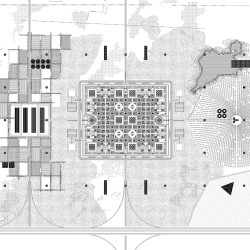
OMA and Squint/Opera have released the video of a prototype for a low-rise hospital that explores the potential of modularity, prefabrication, and automation in relation to the rapid changes occurring in medical science.
Designed by OMA together with BuroHappold, the prototype is the result of the research for the Al Daayan Health District in Doha, commissioned by Hamad Medical Corporation (HMC). Located on a 1.3 million-sqm plot of virgin land, the project explores the potential of modularity, prefabrication, and automation in relation to the rapid changes in medical science.
The centerpiece of the district is a two-story structure that brings together a tertiary teaching hospital, a women’s and children’s hospital and an ambulatory diagnostics center, with a total capacity of 1,400 beds. Clinical facilities occupy the first floor; bed wards are located on the ground floor, reducing the dependency on elevators and allowing patients to enjoy the complex’s generous gardens – healing spaces with a long history in Islamic medical architecture.
Cross-shaped modular units, prefabricated onsite, can be reconfigured and expanded with minimal disruption to ongoing processes, significantly lowering the cost of future adaptations. 3D-printing allows for endless variations in the design of the facades, reintroducing ornament in an architectural typology usually characterized by austerity. A high-tech farm supplies food and medical plants for the local production of medicine. All supporting facilities are connected to the hospitals by an automated underground circulation system. A dedicated logistics center and solar farm enable the district to function autonomously.
Buildable at low cost, with minimum reliance on global supply chains, the Al Daayan Health District aims to establish itself as a prototype which can be adopted globally – an alternative to prevailing hospital models developed in the West.
In the context of rapidly advancing medical innovation, a rethink of the hospital becomes an urgent priority. The Al Daayan Health District presents the perfect opportunity. Located on a 1.3-million-sqm virgin site between Qatar University and the new Lusail City, it offers the possibility for a new symbiosis between architecture and medical science.
A tertiary teaching hospital, a women’s and children’s hospital and an ambulatory diagnostics center, with a total capacity of 1,200 beds are joined into a single structure. Clinical facilities occupy the first floor; bed wards are located on the ground floor, reducing the dependency on elevators and allowing patients to enjoy the complex’s generous gardens – healing spaces with a long history in Islamic medical architecture.
Cross-shaped modular units, prefabricated onsite, can be reconfigured and expanded with minimal disruption to ongoing processes, significantly lowering the cost of future adaptations. 3D-printing allows for endless variations in the design of the facades, reintroducing ornament in an architectural typology usually characterized by austerity. A high-tech farm supplies food and medical plants for the local production of medicine. All supporting facilities are connected to the hospitals by an automated underground circulation system. A dedicated logistics center and solar farm enable the district to function autonomously.
The Al Daayan Health District was commissioned by Hamad Medical Corporation, Qatar’s premier not-for-profit healthcare provider. Buildable at low cost, with minimum reliance on global supply chains, it aims to establish itself as a prototype which can be adopted globally – an alternative to prevailing hospital models developed in the West.
_

project title: al daayan
architecture: OMA / reinier de graaf
client: hamad medical corporation
program: medical masterplan
built area: 629,000 square meters
partner in charge: reinier de graaf
project architect: kaveh dabiri
project manager: alex de jong
team: pablo antuna molina, claudio araya, bozar ben-zeev, joana cidade, benedetta gatti, eve hocheng, sofia hosszufalussy, hanna jankowska, tijmen klone, marina kounavi, hans larsson, roza matveeva, geert reitsma, alex retegan, silvia sandor, elisa versari, arthur wong
visualizations: OMA, tegmark | @tegmark

collaborators:
masterplan engineering: buro happold
clinical architect: henning larsen architects, dutch healthcare architects
stakeholder management: engineering consultants group
landscape architect: michel desvigne paysagiste
cost adviser: de leeuw group
wayfinding: spaceagency












